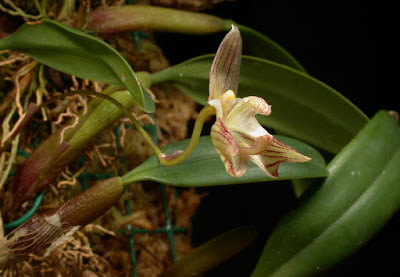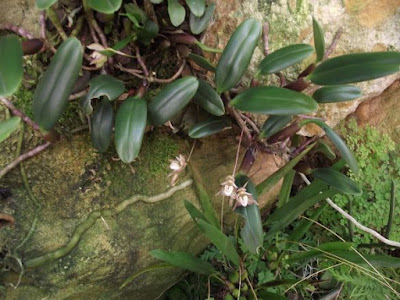Bulbophyllum ambrosia is a fairly common creeping epiphytic or lithophytic orchid. In Vietnam, it grows in evergreen mixed and coniferous forests at an altitude of 500-700 m above sea level. In China, it can be found on the branches of trees in mountain forests at an altitude of up to 1300 m.
Bulbophyllum ambrosia, also called as The Sweet-Smelling Bulbophyllum, Bulbophyllum ambrosia subsp nepalense, Bulbophyllum amygdalinum, Bulbophyllum watsonianum, Eria ambrosia, is a species of the genus Bulbophyllum. This species was described by (Hance) Schlechter in 1919.
IDENTIFY BULBOPHYLLUM AMBROSIA
Bulbophyllum ambrosia is native to China, Hong Kong and Vietnam. It is a quite popular, creeping, epiphytic or rock orchid found in northern Vietnam in the Cao Bang district. They grow in mossy primary and secondary, evergreen, mixed and pinewood forests growing on weathered limestone at heights of 500-700 m. Locally they are abundant, especially on mountain ridges. In China, these plants are found in the provinces of Fujian, Guangdong, Guangxi and the south of the Yunnan province, where they are found growing on branches of trees in mountain forests, at heights up to 1300 m.
It is a small sized, hot to cool growing lithophyte reaching a height of 22 cm. Its growths are located on a creeping rhizome and are spaced from each other by 3-9 cm. A single leave of 3.5-13,0 cm long and 1.2-2.2 cm wide, leathery, erect or bent, with a groove along the central vein, grows from the top of each pseudobulb.
The Sweet-Smelling Bulbophyllum blooms in November to March on an erect, basal, 3" (7.5 cm) long, wiry, single flowered inflorescence arising on old and new unifoliate, ellipsoid, orange-yellow pseudobulbs with the sweetly fragrant flowers held below the leaf. The flowers have a diameter of 1.5 cm. Its sepals are yellowish with purple-red longitudinal veins, ovate or triangular, with sharp tips. Petals of smaller size, triangular, white. The yellowish lip at the base and on the top is decorated with purple-red dots.
BULBOPHYLLUM AMBROSIA CARE AND CULTURE
Cultural information should only be used as a guide, and should be to be adapted to suit you. Your physical location; where you grow your plants, how much time you have to devote to their care, and many other factors, will need to be taken into account. Only then can you decide on the cultural methods that best suit you and your plants.
Light:
Bulbophyllum ambrosia needs a light level of 15000-23000 lux. Light must be filtered or diffused. These plants can not be exposed to direct sunlight. It is necessary to provide constant ventilation.
Temperature:
The plant is moderately thermophilic. In summer the average day temperature is 29 ° C, night 21 ° C, which gives a daily difference of 8 ° C. In winter, the average day temperatures are 15-18 ° C, and the night 6-9 ° C, with a daily amplitude of 7-9 ° C.
Humidity:
This species needs a humidity level of 80-85% for most of the year, only for about one month of winter and then at the end of spring, it drops to 75%.
Substrate, growing media and repotting:
These plants are usually grown in shallow pots or baskets using a loose, fast-drying substrate such as perlite or chopped sphagnum moss mixed with fine or medium granulation bark or tree fern fiber because they require excellent drainage and airy substrate around the roots.
If the substrate is not spread, but Bulbophyllum ambrosia has grown out of the container, it can be repotted with the whole substrate to a larger basket or pot without disturbing the roots. If repotting is necessary, it is best to do it when new roots begin to grow, because then the plant will stabilize faster. However, they should be repotted immediately if the substrate is spread out before it becomes stale and will remain soggy.
Watering:
During active growth (from late spring to autumn), this plants should be kept constantly moist, but the substrate should not be soaked, while around the roots should be ensured excellent aeration. In late autumn, watering should be gradually reduced.
Fertilizer:
During the active growth period, 1/4-1/2 of the recommended fertilizer dose for orchids is fertilized weekly. You can use a balanced fertilizer, with NPK in equal proportions (20-20-20, 5-5-5- 8-8-8...)or use a fertilizer rich in nitrogen from spring to mid-summer and use a fertilizer rich in phosphorus in late summer and autumn. Before fertilizing the plant it is necessary to water it: in this way the roots are not burned by the fertilizer
Rest period:
In winter, Bulbophyllum ambrosia should be allowed to dry a little before the next watering, but it must not be allowed to remain dry for a long period of time. To prevent excessive drying, the plants should be sprinkled fairly early in the morning between watering. Fertilization should be reduced or eliminated until new growths appear and spring watering is started more.















COMMENTS